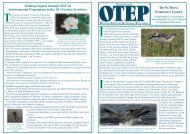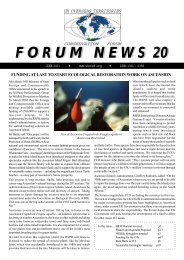Section 06 - UKOTCF
Section 06 - UKOTCF
Section 06 - UKOTCF
Create successful ePaper yourself
Turn your PDF publications into a flip-book with our unique Google optimized e-Paper software.
unlike for the World Heritage Convention, where<br />
the States Party make a nomination with no certainty<br />
it will be successful.<br />
Finally, both conventions allow for existing sites<br />
and properties to be extended. Such extensions<br />
may well be a simpler process to follow than<br />
proposing a new international site. Within a<br />
UKOTCD context, this route has already been<br />
followed, when the UK successfully applied in<br />
2004 for an extension of the Gough Island Wildlife<br />
Reserve to include both a larger marine component<br />
and the Inaccessible Island Nature Reserve, under<br />
the new name of Gough and Inaccessible Islands<br />
World Heritage Property (see footnotes to Table 4).<br />
A way forward for UK Overseas Territories<br />
and Crown Dependencies<br />
The <strong>UKOTCF</strong>’s regional working groups seem<br />
ideally suited to pursue the further declaration of<br />
international sites within UKOTCDs, by actively<br />
advising and by producing proposals, which could<br />
extend to producing draft nomination texts. Where<br />
capacity and/or available finances are limiting<br />
within UKOTCDs (as seems to be the usual case),<br />
then the <strong>UKOTCF</strong> could work in tandem with the<br />
various UKOTCD governments to make funding<br />
applications and help appoint contractors to draft<br />
texts. Such a procedure was broadly followed by<br />
Tristan da Cunha in successfully applying in 2007<br />
for a small grant (GBP 3000) to the UK’s Overseas<br />
Territories Environment Programme (a joint<br />
programme of the Department for International<br />
Development (DFID) and the Foreign and Commonwealth<br />
Office; www.ukotcf.org/OTEP/index.<br />
htm) to complete Ramsar Information Sheets for<br />
the Gough Island and Inaccessible Island Nature<br />
Reserves. The Tristan Government then contracted<br />
with Conservation and Restoration (CORE) Initiatives,<br />
a South African-based environmental consultancy,<br />
to produce the two RISs and electronic<br />
maps. This task was made easier by the existence<br />
of draft RISs for the two island reserves, produced<br />
by <strong>UKOTCF</strong> two years previously (Pienkowski<br />
2005). In fact, draft RISs prepared by the UKO-<br />
TCF exist for all 67 of the proposed Ramsar sites<br />
within UKOTCDs (see Table 4), making any<br />
UKOTCD government able to “hit the ground running”<br />
in working towards a designation.<br />
The situation for World Heritage Sites is, as stated<br />
above, more complex. However, the principle of<br />
utilizing the skills and knowledge base and interest<br />
of the <strong>UKOTCF</strong> and the members of its regional<br />
working groups still applies, although it seems<br />
likely that more input from the responsible UK<br />
Government departments will be required.<br />
Working towards a “wish list” for new international<br />
sites in UK Overseas Territories<br />
and Crown Dependencies<br />
It is proposed that, in principle, all UKOTCDs<br />
should support at least one internationally protected<br />
area. Currently Anguilla, Ascension, British<br />
Antarctic Territory (BAT), Gibraltar, Montserrat,<br />
South Georgia and the South Sandwich Islands,<br />
and St Helena have no designated sites. BAT falls<br />
within the competence of the Antarctic Treaty<br />
and is thus a special case, which is not considered<br />
further here (and anyway has not been included<br />
within the UK ratification of the Wetlands Convention).<br />
Ramsar Sites have been proposed (Table 5) for all<br />
six of these UKOTCDs, totalling 14 sites. For two<br />
UKOTs (Ascension and South Georgia and the<br />
South Sandwich Islands) the whole territory has<br />
been proposed for listing in the Wetlands Convention<br />
(Pienkowski 2005). Designation of a site (or<br />
sites) within the latter UKOT may be seen as problematic<br />
as the territory is claimed by Argentina.<br />
However, this dispute did not deter the UK from<br />
designating in 2001 two Ramsar sites (Table 3)<br />
within the Falkland Islands (which are also claimed<br />
by Argentina). The list of sites on the Ramsar web<br />
site notes that the Argentine Republic has disputed<br />
the Falkland sites “by diplomatic notification”,<br />
which, it can be assumed, it would do once more if<br />
the UK designated a site within South Georgia and<br />
the South Sandwich Islands. The situation with<br />
the BIOT and Mauritius appears broadly analogous<br />
(Chagos Conservation Trust 2009).<br />
Which Ramsar sites are first chosen for designation<br />
from (or from outside) the potential list will<br />
largely depend on each UKOTCD determining its<br />
own priorities, but the following have been suggested<br />
for consideration (M. Pienkowski in litt.):<br />
Sombrero Island and Dog Island & Middle Cay,<br />
Anguilla; Ascension (most protected areas on island<br />
as a consolidated site); Centre Hills, Montserrat;<br />
South Georgia (effectively whole island); and<br />
Central Peaks, St Helena. Given the dry nature of<br />
much of Ascension, the proposed extent includes<br />
the cloud forest, the island’s turtle beaches and<br />
seabird colonies, and certain other areas important<br />
Making the Right Connections: a conference on conservation in UK Overseas Territories, Crown Dependencies and other small island communities, page 218







